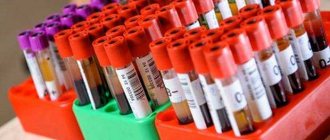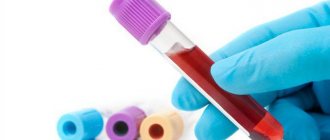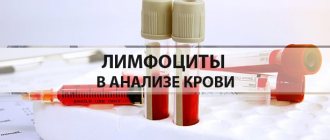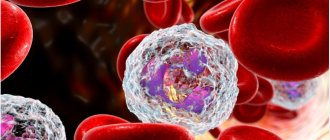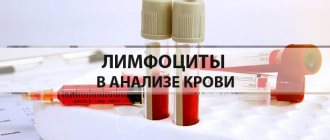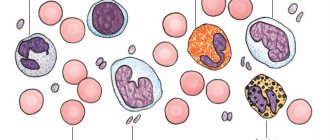Decoding the results is the competence of a pediatrician, therapist or specialist, since it is important not only to analyze the numbers, but also to compare deviations from the norms of different indicators, to compare the information obtained during examination and history taking. To have an overview and be prepared when you see your doctor, learn what blood elements are tested in the laboratory, how to interpret the results, and what abnormalities may mean.
What indicators does the blood test contain?
Donating blood for testing is necessary during planned hospitalization, to assess the effectiveness of the therapy, and during pregnancy. To make an accurate diagnosis and prescribe treatment, the doctor always prescribes a general blood test. Material for research is taken from a finger or from a vein. The second option is preferable, since venous blood more accurately shows the level of hemoglobin and red blood cells.
First of all, red blood cells, white blood cells and platelets are analyzed, as well as:
- Hemoglobin level.
- Erythrocyte indices.
- Hematocrit level.
- Reticulocyte count.
Additionally, the erythrocyte sedimentation rate (ESR), color and blood clotting period are determined.
An extended study involves indicating the leukocyte formula, including the count of eosinophils, lymphocytes, monocytes, band and segmented neutrophils.
Assignment for analysis, preparation and procedure
To test for red blood cells, capillary blood is taken
A blood sample is prescribed during a routine examination, during hospitalization, to assess the patient’s health status in the presence of various complaints and objective indicators. It can show the presence of infection and inflammation, identify diseases of the blood, blood vessels and cardiac system, and become the basis for further in-depth examination.
This type of analysis is important for monitoring the condition of a growing organism, as well as for monitoring the progress of pregnancy.
Blood sampling, which also includes testing for (RBC) red blood cells,
does not require special, special training, but some requirements and instructions from doctors still need to be fulfilled:
- Visiting the laboratory early in the morning before consuming food is a general requirement for any blood sample.
- At least 8 hours before visiting a doctor, you need to abstain from food, but fasting for more than 12 hours is also extremely undesirable - this may affect the accuracy of the indicators, especially if a detailed test is carried out.
- In your diet, a few days before the test, you should avoid fatty, heavy and irritating foods, fried and smoked foods, alcohol and smoking.
- Some types of medications can change the blood picture, so they are either excluded or reported to the doctor if discontinuation is impossible due to health conditions.
- Any overload affects the entire body, including the blood, so heavy physical activity is prohibited before the tests. It is advisable to avoid stress of any kind.
More information about the functions of red blood cells can be found in the video.
Read: Lymphocytes in a child: normal by age
Capillary (finger) blood can be taken for analysis, or it can be taken from a vein. The procedure is quick and not at all painful. After receiving the required amount of blood, the injection hole quickly thromboses and does not require any special care. The trace can be smeared with tincture of iodine or brilliant green if you have to do some work related to contamination immediately after visiting the laboratory.
Interpretation and normal values of the main blood test parameters
| How is it designated? | What does it mean | Norm for women | Norm for men |
| R.B.C. | Red blood cells | 3,5-4,5 | 4,0-5,5 |
| WBC | Leukocytes | 4-9 | |
| PLT | Platelets | 180-320 | |
| HGB | Hemoglobin | 120-140 | 130-170 |
| MCV | Average erythrocyte volume | 82-98 | 81-95 |
| MCH | Average HGB level in erythrocyte | 26-32 | |
| MCHC | Average concentration of red blood cells in HGB (%) | 31-38 | |
| HCT | Hematocrit (in%) | 35-44 | 40-50 |
| RET | Reticulocytes (%) | 0,2-1 | |
| ESR | ESR (mm/h) | 2-15 | 1-10 |
| CPU | Color | 0,85-1,05 | |
The norm of red blood cells in the blood
The red cell count is determined after a general fluid tissue analysis is performed to reveal the true RBC values. These elements perform a number of important tasks, including the transfer of oxygen to cells and the transport of carbon dioxide, the delivery of amino acids to tissues from the digestive system, etc. For this reason, it is important to monitor the number of red blood cells, its dynamics and compliance of the current position with the norm.
When the indicator is normal, red blood cells successfully adsorb toxins, removing them from the body and reducing the pathological effects of harmful agents. Since red cells of liquid tissue are involved in immunological and autoimmune processes, they are classified as components that form immunity. Disturbances in the functioning of the respiratory system, heart, vascular network, and digestive tract are accompanied by deviations in the number of red blood cells from the norm, the values of which are given in the table below (the indicated number according to the age and gender of the patient is standardly multiplied by a factor of 1012, and then divided by a unit of fluid volume - liter) .
| Men | Women | |
| children immediately after birth | 3,9–5,5 | similarly |
| up to a week of age | 3,9–6,6 | similarly |
| from 14 to 30 days | lower limit – 3–3.6, upper – 5.4–6.2 | similarly |
| up to 5 months | lower limit – 2.7–3.4, upper – 4.5–5 | similarly |
| up to three years | 3,4–5 | 3,7–5,2 |
| up to 12 years | 3,5–5 | similarly |
| up to 17 years old | 4,1–5,5 | 3,5–5 |
| up to 20 years | 3,9–5,6 | 3,5–5 |
| adult patients over 20 | 4–5,5 | 3,5–5 |
What deviations in the UAC may mean
For diagnosis, both a current blood test and previous studies are important to track changes. Let's consider what deviations in indicators can mean:
- Red blood cells. Exceeding the value is accompanied by insufficient oxygen supply, dehydration, acquired heart disease, and impaired adrenal function. The level may be lower than normal due to blood loss, iron deficiency anemia, in the second half of pregnancy, and with chronic infectious diseases.
- Leukocytes. Leukocytosis (exceeding the norm) can be caused by physiological characteristics or pathology. In the first case, the causes are: pregnancy, intense physical/psycho-emotional overload, hypothermia/overheating. Inflammatory and oncological diseases, poisoning and allergic reactions are manifested by pathological leukocytosis. With leukemia, bone marrow hypoplasia, liver damage, measles, lymphogranulomatosis, autoimmune diseases, a decrease in leukocytes will be detected.
- Platelets. The amount decreases with leukemia, AIDS, poisoning, bone marrow damage, prolonged therapy with hormones or antibiotics. The indicator goes beyond the normal range with inflammation of the rectal mucosa, osteomyelitis, joint diseases, cancerous lesions, and in the postoperative period.
- Hemoglobin level. Exceeding the norm occurs against the background of an increased platelet count, impaired blood clotting function, after a gastrointestinal disorder, or with an overdose of medications for anemia. Low HGB gives the right to suspect the presence of internal bleeding, kidney dysfunction, malignant neoplasms, and bone marrow damage.
- Erythrocyte indices (MCV, MCH, MCHC). The indicators give an idea of the state of red blood cells and their functionality. MCV is the average volume of one red blood cell; it increases with diseases of the liver and hematopoietic system, lack of folic acid and vitamin B12. Decreased in some types of anemia, hyperthyroidism, hemoglobinopathy. MCH shows the average hemoglobin content in one red blood cell. Analogous to color index. MCHC – average concentration of red blood pigment. The interpretation is carried out taking into account other indices.
- Hematocrit level. Allows you to assess the severity of anemia associated with iron deficiency. Exceeding the norm indicates dehydration, extensive burns, and inflammation of the peritoneum. A low figure gives the right to suspect pathologies of the heart and vascular system, kidney disease, blood disease, extensive blood loss, malaria, and poisoning.
- Reticulocyte count. Exceeding the norm is observed in case of blood loss, poisoning, taking certain medications, during the recovery period after treatment of cancer, diseases of the hematopoietic system, metastases in the bone marrow. A decrease in the number of young red blood cells is caused by: anemia, kidney disease, chronic infections, bone marrow tumors, blood pathologies, myxedema of the thyroid gland, chemotherapy, deficiency of folic acid and vitamin B12.
- ESR. Decreases in heart pathologies, joint diseases, anaphylactic shock. Exceeding the norm is observed during pregnancy, anemia, severe poisoning, exacerbations of chronic diseases, and inflammatory processes in the body.
- Color. Hyperchromia (exceeding the norm) indicates a deficiency of cyanocobalamin, possible polyps in the stomach, various malignant tumors, and a lack of vitamin B9. Hypochromia (decreased color index) indicates anemia or lead poisoning. With normochromia, the doctor looks at the values of other, more informative indicators.
Red blood cells - role and functions
The main function of red blood cells is to carry oxygen and remove carbon dioxide.
Red blood cells are one of the main blood cells, shaped like a disk, concave on both sides. This shape is necessary to increase the absorptive surface of these very small cells. They are also called red blood cells, or corpuscles, because they contain a red pigment - hemoglobin. It is to him that we owe the rich color of our blood.
Red blood cells perform the following functions:
- The lungs take oxygen from the air entering the organ.
- It is transferred to all tissues and organs of the body.
- CO2 is removed.
Thus, red blood cells carry out the process of exchanging oxygen and carbon dioxide, actually performing the most important function of the body - breathing. These cells are classified as highly specialized, that is, they actually perform one action. The role of red blood cells is to supply tissues with oxygen and remove carbon dioxide as a “waste product.”
For the body, these cells are extremely important, since only they can maintain gas exchange. That is why, when prescribing for analysis, the amount of these important tiny blood elements is taken into account. Existing disorders are indicated by both a decrease in the number of cells below normal values and an excess of them. To assess the condition, a blood test called a general blood test is used. It has a separate column - the number of red blood cells. Since now modern laboratories often use imported equipment that automatically produces test results in English.
In printouts, this indicator is indicated by the abbreviation RBC, which stands for Red Blood Cell Count, or the number of red blood cells.
RBC red blood cells are different for people of different ages, they differ in men and women, so this information must be taken into account when decoding the sample data. In addition to these data, such a blood test demonstrates many other important and valuable indicators for assessing the patient’s health status.
Blood composition in women
In women, the composition of the blood often changes depending on the phase of the menstrual cycle or the stage of pregnancy.
Vegetarianism during pregnancy causes particular harm to the hematopoietic system. In conditions when all the body's forces are spent on the development of the fetus, the lack of animal protein in the diet quickly leads to a decrease in the production of red blood cells and, as a result, anemia.
even menstruation can also affect it (usually the amount of menstrual blood does not exceed 200 ml, but in some pathologies the blood loss is more significant). In this case, the RBC count may first fall and then rise sharply as the body tries to compensate for the loss of red blood cells at the expense of their immature counterparts.
Level of indicator in children
In children, a common cause of low red blood cells is poor nutrition. A lack of vitamins, proteins, and iron can seriously affect the hematopoietic system, which will lead to a decrease in the production of red cells.
A child’s body is much more sensitive to the lack of certain substances in food, and besides, children are often overly picky about food. Therefore, with a reduced RBC level, the first task of parents is to ensure that the child begins to eat normally. You should definitely eat meat, apples, pomegranates or pomegranate juice. You can buy hematogen at the pharmacy.
RBC indicator in men
In men, RBC varies more significantly than in women (see table). This is due to a man’s adaptation to heavy physical work and other activities that require exertion.
In particular, the number of RBCs increases in people involved in strength sports.
Red blood cells also increase in smokers .
A decrease in red blood cells is usually caused by a lack of animal protein in the diet, sources of which are meat and fish. Since men have more muscle mass than women, their protein needs are also higher.


